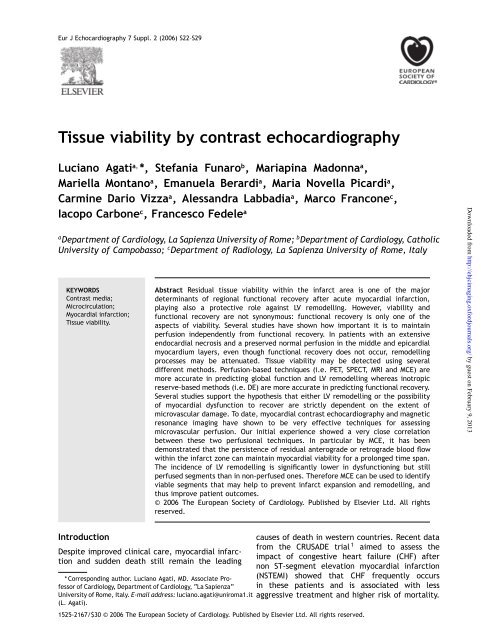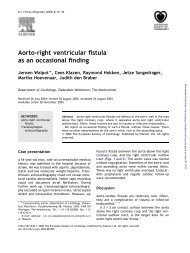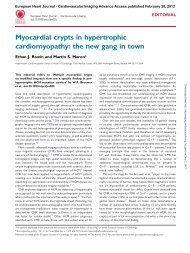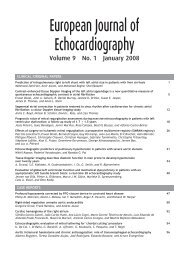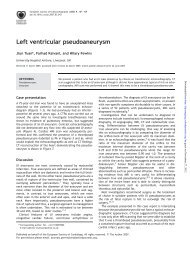Tissue viability by contrast echocardiography - EHJ Cardiovascular ...
Tissue viability by contrast echocardiography - EHJ Cardiovascular ...
Tissue viability by contrast echocardiography - EHJ Cardiovascular ...
You also want an ePaper? Increase the reach of your titles
YUMPU automatically turns print PDFs into web optimized ePapers that Google loves.
Eur J Echocardiography 7 Suppl. 2 (2006) S22–S29<br />
<strong>Tissue</strong> <strong>viability</strong> <strong>by</strong> <strong>contrast</strong> <strong>echocardiography</strong><br />
Luciano Agati a, *, Stefania Funaro b , Mariapina Madonna a ,<br />
Mariella Montano a , Emanuela Berardi a , Maria Novella Picardi a ,<br />
Carmine Dario Vizza a , Alessandra Labbadia a , Marco Francone c ,<br />
Iacopo Carbone c , Francesco Fedele a<br />
a Department of Cardiology, La Sapienza University of Rome; b Department of Cardiology, Catholic<br />
University of Campobasso; c Department of Radiology, La Sapienza University of Rome, Italy<br />
KEYWORDS<br />
Contrast media;<br />
Microcirculation;<br />
Myocardial infarction;<br />
<strong>Tissue</strong> <strong>viability</strong>.<br />
Introduction<br />
Despite improved clinical care, myocardial infarction<br />
and sudden death still remain the leading<br />
Abstract Residual tissue <strong>viability</strong> within the infarct area is one of the major<br />
determinants of regional functional recovery after acute myocardial infarction,<br />
playing also a protective role against LV remodelling. However, <strong>viability</strong> and<br />
functional recovery are not synonymous: functional recovery is only one of the<br />
aspects of <strong>viability</strong>. Several studies have shown how important it is to maintain<br />
perfusion independently from functional recovery. In patients with an extensive<br />
endocardial necrosis and a preserved normal perfusion in the middle and epicardial<br />
myocardium layers, even though functional recovery does not occur, remodelling<br />
processes may be attenuated. <strong>Tissue</strong> <strong>viability</strong> may be detected using several<br />
different methods. Perfusion-based techniques (i.e. PET, SPECT, MRI and MCE) are<br />
more accurate in predicting global function and LV remodelling whereas inotropic<br />
reserve-based methods (i.e. DE) are more accurate in predicting functional recovery.<br />
Several studies support the hypothesis that either LV remodelling or the possibility<br />
of myocardial dysfunction to recover are strictly dependent on the extent of<br />
microvascular damage. To date, myocardial <strong>contrast</strong> <strong>echocardiography</strong> and magnetic<br />
resonance imaging have shown to be very effective techniques for assessing<br />
microvascular perfusion. Our initial experience showed a very close correlation<br />
between these two perfusional techniques. In particular <strong>by</strong> MCE, it has been<br />
demonstrated that the persistence of residual anterograde or retrograde blood flow<br />
within the infarct zone can maintain myocardial <strong>viability</strong> for a prolonged time span.<br />
The incidence of LV remodelling is significantly lower in dysfunctioning but still<br />
perfused segments than in non-perfused ones. Therefore MCE can be used to identify<br />
viable segments that may help to prevent infarct expansion and remodelling, and<br />
thus improve patient outcomes.<br />
© 2006 The European Society of Cardiology. Published <strong>by</strong> Elsevier Ltd. All rights<br />
reserved.<br />
* Corresponding author. Luciano Agati, MD. Associate Professor<br />
of Cardiology, Department of Cardiology, “La Sapienza”<br />
University of Rome, Italy. E-mail address: luciano.agati@uniroma1.it<br />
(L. Agati).<br />
causes of death in western countries. Recent data<br />
from the CRUSADE trial 1 aimed to assess the<br />
impact of congestive heart failure (CHF) after<br />
non ST-segment elevation myocardial infarction<br />
(NSTEMI) showed that CHF frequently occurs<br />
in these patients and is associated with less<br />
aggressive treatment and higher risk of mortality.<br />
1525-2167/$30 © 2006 The European Society of Cardiology. Published <strong>by</strong> Elsevier Ltd. All rights reserved.<br />
Downloaded from<br />
http://ehjcimaging.oxfordjournals.org/ <strong>by</strong> guest on February 9, 2013
<strong>Tissue</strong> <strong>viability</strong> <strong>by</strong> <strong>contrast</strong> <strong>echocardiography</strong> S23<br />
Thus, there is a strong need for preventing postischemic<br />
left ventricular (LV) dysfunction and for<br />
new markers able to identify high risk patients<br />
after acute coronary syndromes.<br />
Prevention of post-ischemic LV dysfunction<br />
The best way to prevent LV dysfunction after acute<br />
myocardial infarction (AMI) is to reduce the time<br />
to treat. There is a general agreement based on<br />
several multicentre trials that independently of<br />
reperfusion strategies, time to reperfusion is the<br />
key determinant of myocardial salvage in patients<br />
with AMI 2 . However, whereas primary percutaneous<br />
coronary intervention (PPCI) or fibrinolysis<br />
are equally recommended for patients presenting<br />
within 3 h of symptom onset, PPCI is superior to<br />
lysis when reperfusion starts 3 h after symptom<br />
onset 3 . A recent survey showed that
S24 L. Agati et al.<br />
Fig. 1. New software is used to identify and track the<br />
endocardial border during contraction. The illustration shows<br />
the endocardial contours at end-diastole and the arrows the<br />
excursion during systole.<br />
an improvement in the definition of all cavities and<br />
borders (Fig. 2).<br />
To increase the diagnostic capability of <strong>echocardiography</strong><br />
we do not need fast but non-diagnostic<br />
procedures in our echo labs. We absolutely need<br />
to spend some more time to produce good and<br />
diagnostic images and this is now feasible with<br />
<strong>contrast</strong>.<br />
Assessment of myocardial infarction and residual<br />
ischemia after AMI<br />
Two recent studies showed in a large series of patients<br />
the additional value of myocardial <strong>contrast</strong><br />
echo in the diagnosis of acute coronary syndrome.<br />
In the first study 21 the authors hypothesized that<br />
regional function and myocardial perfusion may<br />
Fig. 2. Live 3D. Left ventricular opacification for endocardial border enhancement. By using Tomtec software, endocardial surface is<br />
automatically recognized and a 3D reconstruction of LV volume is obtained. Upper panel: two perpendicular long-axis views. Lower<br />
panel: (left) short axis, (right) 3D reconstruction of LV volume.<br />
Downloaded from<br />
http://ehjcimaging.oxfordjournals.org/ <strong>by</strong> guest on February 9, 2013
<strong>Tissue</strong> <strong>viability</strong> <strong>by</strong> <strong>contrast</strong> <strong>echocardiography</strong> S25<br />
be superior to the TIMI score for diagnosis and<br />
prognosis in patients presenting to the emergency<br />
department with chest pain and a non-diagnostic<br />
electrocardiogram. They were able to show that<br />
myocardial <strong>contrast</strong> echo can rapidly and accurately<br />
provide short-, intermediate- and long-term<br />
prognostic information in patients presenting to<br />
the emergency department with suspected cardiac<br />
chest pain even before serum cardiac markers<br />
are known. The second study 22 showed that in<br />
patients with regional wall motion abnormalities,<br />
the contemporary presence of abnormal perfusion<br />
increases the likelihood of adverse events in the<br />
follow-up.<br />
In the first large study 23 in patients undergoing<br />
dobutamine stress for detecting residual ischemia<br />
after acute myocardial infarction, the additional<br />
role of myocardial perfusion over wall motion in<br />
identifying the amount of myocardium at risk has<br />
been clearly demonstrated. Patients with normal<br />
perfusion have a better outcome than patients with<br />
normal wall motion.<br />
The explanation for the additional prognostic<br />
value of myocardial <strong>contrast</strong> perfusion <strong>echocardiography</strong><br />
is related to the way in which bubbles<br />
behave: during hyperaemia all bubbles arrive<br />
quickly in the ROI and at 2 frames after the flash<br />
there is complete replenishment of the bubbles<br />
into the myocardium; if there is a stenosis,<br />
bubbles arrive more slowly and at 1–2 frames<br />
after flash it is not possible to see a complete<br />
replenishment of ROI but only after 4–8 frames.<br />
The majority of inducible perfusion abnormalities<br />
occur at an intermediate phase of stress, without<br />
wall motion abnormalities, thus explaining the<br />
higher sensitivity of perfusion imaging over wall<br />
motion. Myocardial <strong>contrast</strong> echo may be of great<br />
help in identifying residual area of ischemia into<br />
the infarction area or surrounding area.<br />
Assessment of microvascular perfusion within the<br />
infarct area (true infarct size)<br />
<strong>Tissue</strong> <strong>viability</strong> is the main determinant of functional<br />
recovery after acute myocardial infarction.<br />
However, myocyte <strong>viability</strong> and functional recovery<br />
are not synonymous, but the latter has to be<br />
considered as one aspect of the former 24 . <strong>Tissue</strong><br />
<strong>viability</strong> is also very important to prevent postischemic<br />
LV remodelling. In patients with extensive<br />
subendocardial necrosis but preserved normal<br />
perfusion in mid wall and epicardium, even though<br />
functional recovery is not observed, attenuation of<br />
the LV remodelling process may occur. Thus, all the<br />
efforts to assess and maintain tissue <strong>viability</strong> are<br />
strongly justified.<br />
Several techniques 25–33 have been developed<br />
to identify dysfunctional but viable myocardium.<br />
Perfusion-based techniques (i.e. PET, SPECT, MRI<br />
and MCE) are more accurate in predicting global<br />
function recovery and LV remodelling whereas<br />
inotropic reserve-based methods (i.e. dobutamine<br />
stress echo) are more accurate in predicting<br />
regional functional recovery 25–33 . Dobutamine<br />
stress is the best method to assess regional<br />
functional recovery 28,29 . Several studies 30–33 agree<br />
that dobutamine has a high positive predictive accuracy<br />
for predicting functional recovery whereas<br />
thallium has high negative predictive value in<br />
predicting functional recovery, as have MCE or MRI.<br />
Therefore nuclear imaging is highly sensible for cell<br />
<strong>viability</strong> but it overestimates functional recovery.<br />
Dobutamine <strong>echocardiography</strong> is highly specific but<br />
it underestimates the amount of <strong>viability</strong>; MCE<br />
and MRI are the only techniques able to evaluate<br />
microvascular integrity which is a “conditio sine<br />
qua non” for cell <strong>viability</strong> and later functional<br />
improvement 28–33 .<br />
The role of <strong>contrast</strong> <strong>echocardiography</strong> and<br />
magnetic resonance in predicting wall motion<br />
recovery and LV remodelling in patients with<br />
previous MI has been elucidated <strong>by</strong> several<br />
studies 25–33 . In particular, MRI may be considered<br />
as the reference method to detect scar tissue in<br />
post-ischemic LV dysfunction 25–27 . Late gadolinium<br />
enhancement (LGE) is inversely related to recovery<br />
of systolic thickening. There is a >7-fold increase in<br />
major adverse coronary events in patients with late<br />
enhancement, finally there is a close correlation<br />
between LGE and life-threatening arrhythmias.<br />
Thus, the extent of scar tissue can be considered<br />
as a new marker for identifying patients at high<br />
risk of sudden cardiac death caused <strong>by</strong> ventricular<br />
dysrhytmia and who could be candidates for ICD<br />
implantation.<br />
Similar data has been obtained <strong>by</strong> MCE, as<br />
depicted in Figs. 3 and 4. Balcells et al. 34 showed a<br />
close correlation between <strong>contrast</strong> score at 3 days<br />
after MI and wall motion score at 4 weeks. Lepper<br />
et al. 35 and Badano et al. 36 demonstrated that the<br />
best predictor of left ventricular recovery is the<br />
extent of perfusion defect.<br />
In our study 37,38 we showed a closer correlation<br />
between <strong>contrast</strong> defect at day 1 and wall motion<br />
abnormalities at follow-up than between the initial<br />
and final extent of wall motion abnormalities<br />
(Fig. 5). In other words, the status of microvascular<br />
perfusion after reperfusion is the most powerful<br />
predictor of EF and definitive extent of infarct size<br />
at follow-up.<br />
Downloaded from<br />
http://ehjcimaging.oxfordjournals.org/ <strong>by</strong> guest on February 9, 2013
S26 L. Agati et al.<br />
Fig. 3. Patient with acute apical myocardial infarction treated<br />
with primary angioplasty within 3 hours from symptom onset.<br />
No late enhancement or residual <strong>contrast</strong> defect is detected<br />
<strong>by</strong> either (A) magnetic resonance imaging or (B) myocardial<br />
<strong>contrast</strong> echo.<br />
Fig. 4. Patient with acute apical myocardial infarction treated<br />
with primary angioplasty within 3 hours from symptom onset.<br />
Similar extent of late enhancement and residual <strong>contrast</strong><br />
defect is detected both <strong>by</strong> (A) magnetic resonance imaging and<br />
(B) myocardial <strong>contrast</strong> echo.<br />
Fig. 5. Linear regression analysis shows a closer correlation between <strong>contrast</strong> defect at day 1 (CD%-T1) and wall motion abnormalities<br />
at follow up (WMA%-T3) (left panel) than between the initial (WMRA-T1) and final (WMA%-T3) extent of wall motion abnormalities<br />
(right panel).<br />
Downloaded from<br />
http://ehjcimaging.oxfordjournals.org/ <strong>by</strong> guest on February 9, 2013
<strong>Tissue</strong> <strong>viability</strong> <strong>by</strong> <strong>contrast</strong> <strong>echocardiography</strong> S27<br />
Fig. 6. ROC curves analysis considering all clinical, echocardiographic and angiographic parameters together. Contrast defect (CD%)<br />
shows the best sensitivity/specificity ratio. Abbreviations: RWMSI, regional wall motion score index; RCSI, regional <strong>contrast</strong> score<br />
index; WMA%, wall motion abnormalities; CD%, <strong>contrast</strong> defect; EDV, end-diastolic volume; EF, ejection fraction.<br />
Assessment of left ventricular remodelling<br />
After acute myocardial infarction, aging and time<br />
to treat are the major determinants of subsequent<br />
LV dysfunction, thus of the initial extent of wall<br />
motion abnormalities (WMA) and end-diastolic LV<br />
volume (EDV). All these parameters play a major<br />
role in inducing LV remodelling 39–46 . However, the<br />
initial extent of regional wall motion abnormalities<br />
provides indirect measures of infarct size whereas<br />
myocardial <strong>contrast</strong> <strong>echocardiography</strong> <strong>by</strong> assessing<br />
the extent of microvascular perfusion defect<br />
represents a direct measure of true infarct size.<br />
For these reasons, patients with similar extent<br />
of WMA and EDV soon after reperfusion may have<br />
different LV remodelling. The missing link is the<br />
microvascular damage, which explains why for<br />
similar volumes, ejection fraction and extent of<br />
regional wall motion abnormalities, LV remodelling<br />
can be different. LV remodelling may occur from<br />
24–48 hours after reperfusion to pre-discharge<br />
(early LV remodelling) or from pre-discharge to<br />
6 months (late LV remodelling). Different parameters<br />
may predict early and late remodelling. According<br />
to the GISSI 3 echo sub-study 43 EDV and the<br />
extent of WMA are important for predicting early<br />
remodelling; however for late remodelling prediction,<br />
EDV is not always so specific. Late remodelling<br />
is associated with progressive deterioration of<br />
global ventricular function over time: patients<br />
with extensive WMA and not significantly enlarged<br />
ventricular volume before discharge are at higher<br />
risk for progressive dilation and LV dysfunction.<br />
Nicolau et al. 44 pointed out for the first time the<br />
importance of microvascular perfusion, showing<br />
that the presence of ST-segment resolution after<br />
MI precludes the occurrence of remodelling.<br />
Similar conclusions were drawn <strong>by</strong> Bolognese<br />
et al. 42,45 demonstrating the correlation between<br />
microvascular dysfunction within the risk area and<br />
LV remodelling and survival at follow-up.<br />
Our data obtained during a multicentre Acute<br />
Myocardial Infarction Imaging (A.M.I.C.I) study<br />
conducted at 4 institutions in Italy on 120 patients<br />
with first acute ST-elevation acute myocardial<br />
infarction undergoing different reperfusion strategies<br />
within 6 hours from symptom onset 14,37,39,46 ,<br />
further confirm the key role of MCE in predicting<br />
LV remodelling. From multivariate analysis<br />
using Cox regression, the most important echo<br />
parameters for predicting LV remodelling at day 1<br />
after reperfusion are <strong>contrast</strong> defect (CD) and<br />
WMA extent and ejection fraction. However from<br />
analysis of ROC curves the most powerful predictor<br />
of LV remodelling with the best sensitivity/<br />
specificity ratio is the CD extent (Fig. 6).<br />
Considering all clinical, echocardiographic and<br />
angiographic parameters together (i.e. ST-segment<br />
reduction, all echo and angio parameters) the<br />
CD extent, TIMI post and ejection fraction are the<br />
most important parameters to predict remodelling<br />
Downloaded from<br />
http://ehjcimaging.oxfordjournals.org/ <strong>by</strong> guest on February 9, 2013
S28 L. Agati et al.<br />
Table 1<br />
Multivariate analysis: Cox regression<br />
Independent LVR predictors<br />
CD1 cut-off 21.7 (HR = 3.75; 95% CI: 1.19–11.80)<br />
TIMI post cut-off 3 (HR = 0.40; 95% CI: 0.17–0.99)<br />
Selecting only TIMI 3 after reperfusion<br />
CD1 cut-off 21.7 (HR = 4.91; 95% CI: 1.32–18.17)<br />
(Table 1). Therefore, <strong>contrast</strong> defect as compared<br />
to ST-segment reduction after reperfusion more<br />
strongly reflects the efficacy of reperfusion and<br />
it should be used routinely for assessing different<br />
reperfusion strategies. In the subset of patients<br />
reaching TIMI 3 score after reperfusion, multivariate<br />
analysis shows CD extent is the only independent<br />
parameter for LV remodelling (Table 1).<br />
Conclusions<br />
Microvascular damage is the missing link between<br />
LV remodelling infarct size and LV volumes.<br />
After acute myocardial infarction, MCE or MRI<br />
are the ideal methods for (1) assessing residual<br />
tissue <strong>viability</strong>, (2) following perfusional changes,<br />
and (3) evaluating the efficacy of treatment.<br />
The extent of scar tissue as detected <strong>by</strong> MRI<br />
or MCE can be considered as a new marker for<br />
identifying patients at high risk for sudden cardiac<br />
death caused <strong>by</strong> ventricular dysrhytmia, and it<br />
may be used for a better selection of patients as<br />
candidates for ICD implantation.<br />
References<br />
1. Roe MT, Chen AY, Riba AL, Goswami RG, Peacock F,<br />
Pollack AL, Peterson ED; for the CRUSADE Investigators.<br />
Impact of congestive heart failure in patients with non-<br />
ST segment elevation in acute coronary syndromes. Am J<br />
Cardiol 2006;97:1707–12.<br />
2. De Luca G, Suryapranata H, Ottervanger JP, Antman EM.<br />
Time delay to treatment and mortality in primary<br />
angioplasty for acute myocardial infarction. Circulation<br />
2004;109:1223–5.<br />
3. Widimsky P, Budesinsky T, Vorac D, Groch L, Zeliko M,<br />
Aschermann M, et al.; on behalf of PRAGUE Study Group<br />
Investigators. Long distance for primary angioplasty vs.<br />
immediate thrombolysis in acute myocardial infarction. Eur<br />
Heart J 2003;24:94–104.<br />
4. Nallamothu BK, Bates ER, Herrin J, Wang Y, Bradley EH,<br />
Krumholz HM; for the NRMI investigators. Times to<br />
treatment in transfer patients undergoing primary<br />
percutaneous coronary intervention in the United States.<br />
Circulation 2005;111:761–7.<br />
5. Huber K, De Caterina R, Kristensen SD, Verheugt FW,<br />
Montalescot G, Maestro L, et al. Pre-hospital reperfusion<br />
therapy: a strategy to improve therapeutic outcome<br />
in patients with ST-elevation myocardial infarction. Eur<br />
Heart J 2005;26:2063–74.<br />
6. Antman EM, Van de Werf F. Pharmacoinvasive therapy. The<br />
future treatment for ST-elevation myocardial infarction.<br />
Circulation 2004;109:2480–6.<br />
7. Le May MR, Wells GA, Labinaz M, Davies RF, Turek M,<br />
Leddy D, et al. Combined angioplasty and pharmacological<br />
intervention vs thrombolysis alone in acute myocardial<br />
infarction (CAPITAL AMI study). J Am Coll Cardiol<br />
2005;46:417–24.<br />
8. Mc Clelland AJ, Owens CG, Walsh SJ, McCarty D, Mathew T,<br />
Stvenson M, et al. Percutaneous coronary intervention and<br />
1 year survival in patients treated with fibrinolytic therapy<br />
for acute ST-elevation myocardial infarction. Eur Heart J<br />
2005;26:544–8.<br />
9. Gibson CM, Karha J, Murphy SA, James D, Morrow DA,<br />
Cannon CP, et al.; for the TIMI Study Group. Early and<br />
long-term clinical outcomes associated with reinfarction<br />
following fibrinolytic administration in the thrombolysis<br />
in myocardial infarction trials. J Am Coll Cardiol<br />
2003;42:7–16.<br />
10. Scheller B, Hennen B, Hammer B, Walle J, Hofer C, Hilpert V,<br />
et al.; for the SIAM III Study Group. Beneficial effects of<br />
immediate stenting after thrombolysis in acute myocardial<br />
infarction. J Am Coll Cardiol 2003;42:634–41.<br />
11. Fernandez-Aviles F, Alonso JJ, Castro-Beiras A, Vazquez N,<br />
Blanco J, Alonso-Briales J, et al.; on the behalf of the<br />
GRACIA Group. Routine invasive strategy within 24 hours<br />
after thrombolysis versus ischaemia-guided conservative<br />
approach for acute myocardial infarction with ST-segment<br />
elevation (GRACIA-1): a randomized controlled trial. Lancet<br />
2004;363:1045–53.<br />
12. Steg PG, Bonnefoy E, Chabaud S, Lapostolle F, Dubien P-Y,<br />
Cristofini P, et al.; for the Comparison of Angioplasty<br />
Prehospital Thrombolysis in Acute Myocardial Infarction<br />
(CAPTIM) Investigators. Impact of time to treatment<br />
on mortality after prehospital fibrinolysis or primary<br />
angioplasty: data from CAPTIM randomized clinical trial.<br />
Circulation 2003;108:2851–6.<br />
13. Armstrong PW, WEST Steering Committee. A comparison<br />
of pharmacologic therapy with/without timely coronary<br />
intervention vs. primary percutaneous intervention early<br />
after ST-elevation myocardial infarction: the WEST (Which<br />
Early ST-elevation myocardial infarction Therapy) study. Eur<br />
Heart J 2006;27:1530–8.<br />
14. Funaro S, Agati L, Galiuto L, Di Bello V, Madonna MP,<br />
Garramone B, et al. Impact of 4 different reperfusion<br />
strategies on microvascular damage after AMI. Results from<br />
the acute myocardial infarction <strong>contrast</strong> imaging (AMICI)<br />
multicenter study. Eur J Echocardiogr 2005;6:S110.<br />
15. Agati L, Autore C, Iacoboni C, Castaldo M, Veneroso G,<br />
Voci P, et al. The complex relation between myocardial<br />
<strong>viability</strong> and functional recovery in chronic left ventricular<br />
dysfunction. Am J Cardiol 1998;81:33G–35G.<br />
16. Bonow RO, Dilsizian V, Cuocolo A, Bachrach SL. Identification<br />
of viable myocardium in patients with chronic coronary<br />
artery disease and left ventricular dysfunction. Circulation<br />
1991;83:26–37.<br />
17. Rahimtoola SH. The hibernating myocardium. Am Heart J<br />
1989;117:211–21.<br />
18. Bolli R: Myocardial stunning in man. Circulation 1992;86:<br />
1671–91.<br />
19. Agati L, Voci P, Bilotta F, Luongo R, Autore C,<br />
Penco M, et al. Influence of residual perfusion within<br />
the infarct zone on the natural history of left ventricular<br />
dysfunction after acute myocardial infarction: a myocardial<br />
<strong>contrast</strong> echocardiographic study. J Am Coll Cardiol<br />
1994;24:336–42.<br />
Downloaded from<br />
http://ehjcimaging.oxfordjournals.org/ <strong>by</strong> guest on February 9, 2013
<strong>Tissue</strong> <strong>viability</strong> <strong>by</strong> <strong>contrast</strong> <strong>echocardiography</strong> S29<br />
20. Hoffmann R, von Bardeleben S, Kasprzak JD, Borges AC,<br />
ten Cate F, Firschke C, et al. Analysis of regional<br />
left ventricular function <strong>by</strong> cineventriculography, cardiac<br />
magnetic resonance imaging and unenhanced and <strong>contrast</strong><br />
<strong>echocardiography</strong>: a multicenter comparison of methods<br />
J Am Coll Cardiol 2006;47:121–8.<br />
21. Tong KL, Kaul S, Wang XQ, Kalavaitis S, Belcik T,<br />
Lepper W, et al. Myocardial <strong>contrast</strong> <strong>echocardiography</strong><br />
versus thrombolysis in myocardial infarction score in<br />
patients presenting to the emergency department with<br />
chest pain and non diagnostic electrocardiogram. J Am Coll<br />
Cardiol 2005;46:920–7.<br />
22. Rinkevich D, Kaul S, Wang XQ, Belcik T, Kalavaitis S,<br />
Lepper W, et al. Regional left ventricular perfusion<br />
and function in patients presenting to the emergency<br />
department with chest pain and no ST-segment elevation.<br />
Eur Heart J 2005;26:1606–11.<br />
23. Tsutsui JM, Elhendy A, Anderson JR, Xie F, McGrain MC,<br />
Porter TR. Prognostic value of dobutamine stress myocardial<br />
<strong>contrast</strong> perfusion <strong>echocardiography</strong>. Circulation 2005;112:<br />
1444–50.<br />
24. Agati L. Microvascular integrity after reperfusion therapy.<br />
Am Heart J 1999;138:76–9.<br />
25. Kim RJ, Wu E, Rafael A, Parker MA, Chen EL, Simonetti O,<br />
et al. The use of <strong>contrast</strong> enhanced magnetic resonance<br />
imaging to identify reversible myocardial dysfunction.<br />
N Engl J Med 2000;343:1445–53.<br />
26. Baks T, Cademartiri F, Moelker AD, Weustink AC, Van<br />
Geuns R, Mollet NR, et al. Multislice computed tomography<br />
and magnetic resonance imaging for the assessment of<br />
reperfused acute myocardial infarction, J Am Coll Cardiol<br />
2006;48:144–52.<br />
27. Kwong RY, Chan AK, Brown KA, Chan CW, Reynolds HG,<br />
Davis RB. Impact of unrecognized myocardial scar detected<br />
<strong>by</strong> cardiac magnetic resonance imaging on event free<br />
survival in patients presenting with signs or symptoms of<br />
coronary artery disease. Circulation 2006;113:2733–43.<br />
28. Bax J, Wijns W, Cornel JH, Visser CA, Boersma E, Fioretti PM.<br />
Accuracy of currently available techniques for prediction<br />
of functional recovery after revascularization in patients<br />
with left ventricular dysfunction due to chronic coronary<br />
artery disease: comparison of pooled data. J Am Coll Cardiol<br />
1997;30:1451–60.<br />
29. Bax JJ, Cornel JH, Visser CA, et al. Prediction of recovery<br />
of myocardial dysfunction following revascularization:<br />
comparison of 18 F-fluorodeoxyglucose/thallium-201 single<br />
photon emission computed tomography, thallium-201 stressreinjection<br />
single photon emission computed tomography<br />
and dobutamine <strong>echocardiography</strong>. J Am Coll Cardiol<br />
1996;28:558–64.<br />
30. Arnese M, Cornel JH, Salustri A, et al. Prediction<br />
of improvement of regional left ventricular function<br />
after surgical revascularization: a comparison of lowdose<br />
dobutamine <strong>echocardiography</strong> with 201-Tl SPECT.<br />
Circulation 1995;91:2748–52.<br />
31. Perrone-Filardi P, Pace L, Prastaro M, et al. Assessment<br />
of myocardial <strong>viability</strong> in patients with chronic coronary<br />
artery disease: rest–4-hour–24-hour 201 Tl tomography<br />
versus dobutamine <strong>echocardiography</strong>. Circulation 1996;94:<br />
2712–9.<br />
32. De Filippi CR, Willett DWL, Irani WN, Eichhorn EJ,<br />
Velasco CE, Grayburn PA. Comparison of myocardial<br />
<strong>contrast</strong> <strong>echocardiography</strong> and low-dose dobutamine stress<br />
<strong>echocardiography</strong> in predicting recovery of left ventricular<br />
function after coronary revascularization in chronic<br />
ischemic heart disease. Circulation 1995;92:2863–8.<br />
33. Agati L, Voci P, Autore C, Luongo R, Testa G, Mallus MT,<br />
et al. Combined use of dobutamine <strong>echocardiography</strong> and<br />
myocardial <strong>contrast</strong> <strong>echocardiography</strong> in predicting regional<br />
dysfunction recovery after coronary revascularization in<br />
patients with recent myocardial infarction. Eur Heart J<br />
1997;18:771–9.<br />
34. Balcells E, Powers ER, Lepper W, Belcik T, Wei K,<br />
Ragosta M, et al. Detection of myocardial <strong>viability</strong> <strong>by</strong><br />
<strong>contrast</strong> <strong>echocardiography</strong> in acute infarction predicts<br />
recovery of resting function and contractile reserve. J Am<br />
Coll Cardiol 2003;41:827–33.<br />
35. Lepper W, Hoffmann R, Kamp O, Franke A, de Cock CC,<br />
Kühl H, et al. Assessment of myocardial reperfusion<br />
<strong>by</strong> intravenous myocardial <strong>contrast</strong> <strong>echocardiography</strong><br />
and coronary flow reserve after primary percutaneous<br />
transluminal coronary angiography in patients with acute<br />
myocardial infarction. Circulation 2000;101:2368–75.<br />
36. Badano LP, Werren M, Di Chiara A, Fioretti PM. Contrast<br />
echocardiographic evaluation of early changes in myocardial<br />
perfusion after recanalization therapy in anterior wall<br />
acute myocardial infarction and their relation with early<br />
contractile recovery. Am J Cardiol 2003;91:532–7.<br />
37. Agati L, Tonti G, Galiuto L, Di Bello V, Funaro S, Madonna MP,<br />
et al.; A.M.I.C.I. Investigators. Quantification methods in<br />
<strong>contrast</strong> <strong>echocardiography</strong>. Eur J Echocardiogr 2005 Dec;<br />
6(Suppl 2):S14–20.<br />
38. Agati L, Funaro S, Veneroso G, Volponi C, Tonti G. Clinical<br />
utility of <strong>contrast</strong> <strong>echocardiography</strong> in the management of<br />
patients with acute myocardial infarction. Eur Heart J 2002;<br />
4(suppl C):C27–34.<br />
39. Agati L, Funaro S, Volponi C, Veneroso G, Autore C. Influence<br />
of microvascular damage on left ventricular remodelling<br />
after acute myocardial infarction. J Am Coll Cardiol 2001;<br />
37(Suppl A):390A.<br />
40. Ragosta M, Camarano G, Kaul S, Powers ER, Sarembock IJ,<br />
Gimple LW. Microvascular integrity indicates myocellular<br />
<strong>viability</strong> in patients with recent myocardial infarction.<br />
New insights using myocardial <strong>contrast</strong> <strong>echocardiography</strong>.<br />
Circulation 1994;89:2562–9.<br />
41. Senior R, Swinburn JM. Incremental value of myocardial<br />
<strong>contrast</strong> <strong>echocardiography</strong> for the prediction of recovery<br />
of function in dobutamine nonresponsive myocardium early<br />
after acute myocardial infarction. Am J Cardiol 2003;91:<br />
397–402.<br />
42. Bolognese L, Neskovic A, Parodi G, et al. Left ventricular<br />
remodelling after primary coronary angioplasty. Circulation<br />
2002;106:2351–7.<br />
43. Bosimini E, Giannuzzi P, Temporelli PL, Gentile F, Lucci D,<br />
Maggioni AP, et al., and the GISSI-3 Echo Sub study<br />
Investigators. Electrocardiographic evolutionary changes<br />
and left ventricular remodelling after acute myocardial<br />
infarction. Results of the GISSI-3 Echo sub study. J Am Coll<br />
Cardiol 2000;35:127–35.<br />
44. Nicolau JC, Maia LN, Vitola J, Vaz VD, Machado MN,<br />
Godoy MF, et al. ST-segment resolution and late (6-month)<br />
left ventricular remodelling after acute myocardial<br />
infarction. Am J Cardiol 2003;91(4):451–3.<br />
45. Bolognese L, Carrabba N, Parodi G, Santoro GM, Buonamici P,<br />
Cerisano G, et al. Impact of microvascular dysfunction on<br />
left ventricular remodelling and long-term clinical outcome<br />
after primary coronary angioplasty for acute myocardial<br />
infarction. Circulation 2004;109:1121–6.<br />
46. Galiuto L, Agati L, Madonna MP, Funaro S, Tonti G, Di<br />
Bello V, et al. Microvascular and myocardial correlates of<br />
persistent ST segment elevation after PCI. Results from<br />
the acute myocardial infarction <strong>contrast</strong> imaging (A:M:I:C:I)<br />
multicenter study. Eur J Echocardiogr 2005;6:S41.<br />
Downloaded from<br />
http://ehjcimaging.oxfordjournals.org/ <strong>by</strong> guest on February 9, 2013


